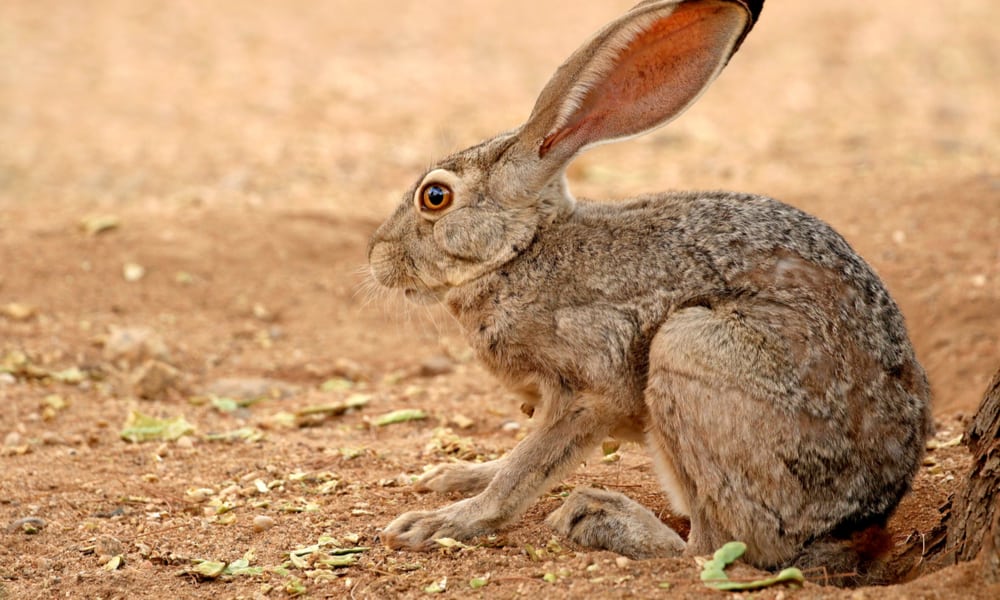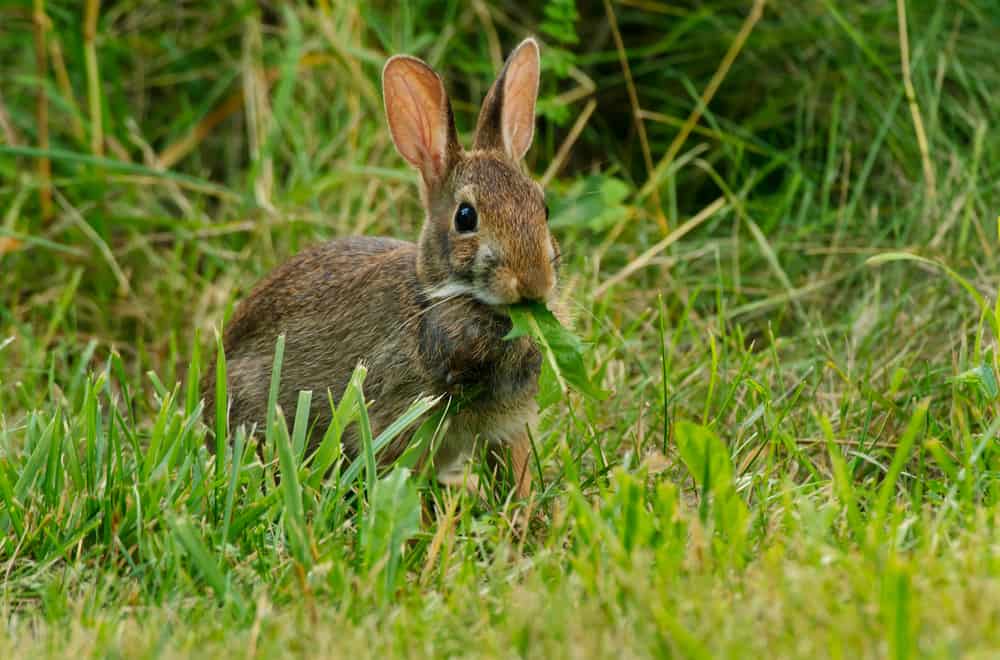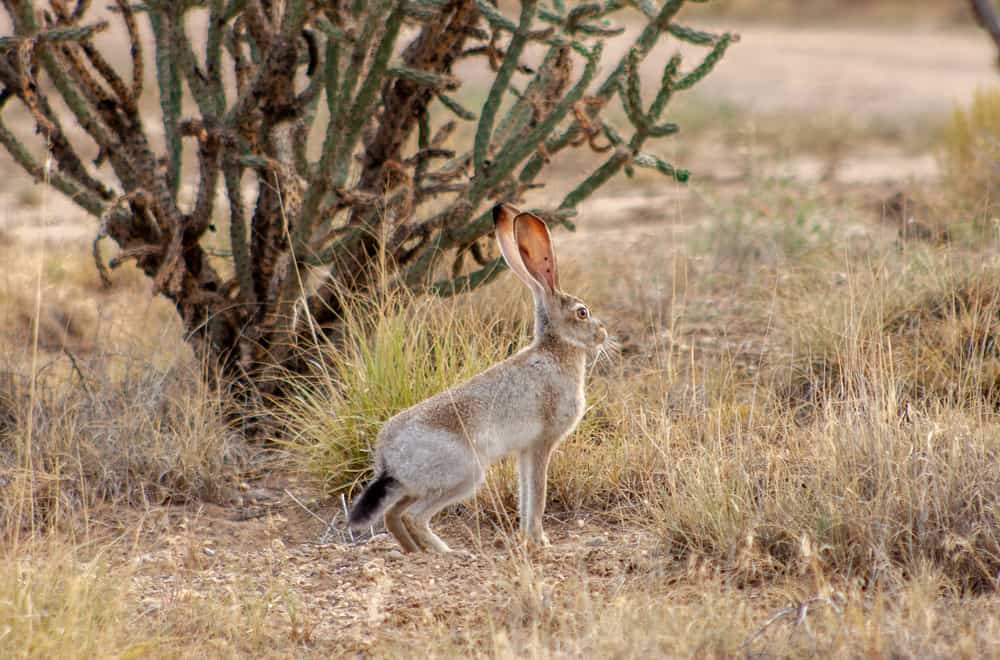You may have come across creatures with long ears and long hind legs that seem very similar to rabbits. Chances are, they are jackrabbits. And perhaps you even wondered, “What do jackrabbits eat?” We will be exploring that in a minute, but first, let’s learn a little bit about their life.
Jackrabbits Habits and Biology
Interestingly, jackrabbits are not rabbits at all. They are hares; despite their resemblance. There are six main species of jackrabbits. Four of the species are found in North America, while the other two are found in Central America. These include; the black-tailed, the antelope, the white-sided, the Tehuantepec, and the white-tailed jackrabbit.
Jackrabbits are huge; however, their size varies depending on the species. The white-tailed jackrabbit is the largest of the species. This species can reach a weight of about 10 pounds and a length of over 2 feet. The black-tailed jackrabbit is a medium-sized rabbit that weighs between four and eight pounds. Their overall length ranges from 18 to 26 inches
Jackrabbits come in a variety of colors and shapes, but most are tan, grey, silver, brown, or black, and their ears are likewise very big.
Most jackrabbits dwell in similar areas, but they will survive in a range of ecosystems if they have enough food. They prefer wide spaces with few if any trees or huge plants. Scrubland, farmland, prairie, desert, and other arid-environment habitats are some of the areas you will mostly find them. Their enormous ears aid in thermoregulation, allowing them to thrive in hot areas.
Jackrabbits can see in front, to the side, and behind them, because their eyes are on the sides of their heads. Their eyes are utilized to detect motion. They have a keen sense of hearing and smell too and their ears and nose are constantly moving to detect sounds and odors in their environment.
When panicked, the jackrabbit may jump up to 20 feet in a single hop. Reaching speeds of up to 40 miles per hour.
Watch this video to learn more about jackrabbits and their behavior: https://www.youtube.com/watch?v=PTljPpmJM6o
What Do Jackrabbits Eat in The Wild?
Jackrabbits are herbivores. They mainly eat plants, grasses, mesquite, and cacti, their favorite food being alfalfa. To aid in the digestion of this difficult vegetation, the jackrabbit’s appendix functions as a pre-digesting chamber, breaking down food sources before they reach the stomach.
The jackrabbit leaves neatly clipped diagonal slashes on plant stalks when feeding. It has two rows of upper incisors, with little secondary teeth just behind the major incisors. Jackrabbits seek food early in the mornings and late in the nights, sleeping in shallow depressions in the shade during the day.
Here is a video that shows more about the jackrabbits’ eating behavior:
What Do Jackrabbits Like To Eat?
Jackrabbits mainly eat a wide variety of green plants such as;
Herbaceous plants: These are grazed during the green-up periods and include:
- Graminoids
- Ferns
- Forbs
Grasses: In places and times when the weather leaves nothing but grass for them to feast on, they will fully oblige with a keen interest in grasses such as:
- Grama grass
- Bamboo
- Dropseed grass
Other delicacies that so often fill the bellies of jackrabbits include;
- Sedges
- Barks
- Buds
- Roots
- Twigs
- Fruits of prickly pear
- Fruits of a pincushion cactus (Mammillaria vivipara)
They also enjoy the thrill of eating crops such as;
- Barley
- Winter wheat
Shrubs and small trees: Jackrabbits often eat small trees during the dry seasons when the herbaceous plants are recovering including:
- Holly
- Hawthorn
How Jackrabbit’s Diet Benefits the Ecosystem
- With the rising population of jackrabbits in some places due to their insatiable appetite and rapid breeding, they have been known to be an important source of food for predators such as coyotes, foxes, and mountain lions.
- Jackrabbits help increase the viability of some seeds in their pellets by their digestive processes. For instance, prickly pears have been known to increase in number in great part because of jackrabbits.
- Jackrabbits control the spread of unnecessary plants by actively feeding on them. Some of this vegetation turns out to be a nuisance and may expand out of control, leaving little to no growth of more acceptable native species.
- They also help in the distribution of plant species across a vast piece of area. When grazing, jackrabbits eat some fruits, moving their seeds to various places. These seeds eventually drop to the ground and germinate into big plants.
- Jackrabbits’ population density has also been vital in influencing the behavior of golden eagles and other predators.
Facts About Jackrabbits
1. Jackrabbits are Not Really Rabbits
You heard that right! They’re hares, a genus related to rabbits that is nearly indistinguishable from rabbits except for their longer ears and solitary lifestyle. Jackrabbits have particularly enormous ears (almost 5 in long), which allow them to hear clearly over long distances while also allowing them to expel heat.
Rabbits have shorter ears and smaller rear legs than hares, which have longer ears and stronger hind legs. Hares also prefer to dwell above ground, whereas rabbits prefer to live in tunnels.
2. Jackrabbits are Nocturnal
The hares spend the majority of their time awake at night, feeding and foraging most of the time. During the day, they hide in “forms,” shallow depressions excavated into the earth and usually covered in plants to keep predators and passers-by at bay. They also occasionally alter tortoise burrows that have been abandoned during hibernation.
3. Jackrabbits Are Massive Breeders
Jackrabbits, like other rabbits and hare species, have a large number of progeny. Every year, a female can have several litters of offspring, each litter containing one to six jackrabbit babies.
The babies can run within half an hour of birth and require very little care and assistance. After two weeks, they are capable of scavenging for food on their own, and after two months, they are entirely self-sufficient.
4. Jackrabbits are Listed as not Endangered
Despite that fact, certain places have had population reductions; Yellowstone hasn’t seen a white-tailed jackrabbit since 1990, while Grand Teton hasn’t seen one since 1978. They used to be plentiful in both. In Missouri and Kansas, they are even assumed to be extinct. Competition with other jackrabbits and hare species could be one reason for the decline.
The black-tailed jackrabbit is more efficient at surviving in devastated habitats than the white-tailed jackrabbit.
Another source of concern is sickness in jackrabbit populations, as well as bad weather. In addition, because jackrabbits eat a diverse diet, they can even subsist on crops. Farmers resent them as a result of this, and this could also be a reason for their decline in number.
5. Jackrabbits Can Be Found All Over North America
Jackrabbits will especially be found in the Central and Western regions. They prefer to live in open spaces such as deserts and scrublands. It’s no wonder they are referred to as prairie hares in some places.
Grass and plants, notably cactus, are part of their diet. They must consume a large amount of food on a daily basis in order to maintain their energy levels.
6. Jackrabbits are Solitary Creatures
At least most of the time except during the breeding season, which runs from February to July. The phrase “as furious as a March hare” refers to jackrabbits’ unique “boxing” activity, which is most common in the spring. When females desire to avoid copulation, they beat males with their paws.
7. Jackrabbits Have a Low Level of Parental Care
The nursing phase is brief, and children begin their independent lives soon after birth. In the wild, jackrabbits can live for one to five years.
8. Jackrabbits Have a Unique Set of Teeth
Jackrabbits have two rows of upper incisors, with little secondary teeth just behind the major incisors. They must constantly munch on grass to wear down these teeth, which never stop growing. The hares hunt for food early in the mornings and late in the nights, sleeping in shallow depressions in the shade during the day.
9. Jackrabbits Can Reach Speeds of Up To 40mph
Besides using sharp senses and effective camouflage to evade predators, speed is another trait built in jackrabbits, with every four to five hops being unusually high to notice their surroundings or predators when running at pace.
With its ears flat and tail between its haunches, the jackrabbit runs! Rather than moving around objects, it will leap over them with fast jumps.
10. Jackrabbits are Herbivores
They feed on a wide range of plants including grasses, mesquite, and cacti, with one of their favorite food being alfalfa. A variety of cereals make up their diet, but jackrabbits will mostly feed on dry and woody vegetation throughout the winter season.
Summary
Jackrabbits are very unique creatures with a generalized diet that focuses purely on a wide variety of plants, grasses, shrubs, mesquite, cacti, roots, alfalfa, and even crops. While eating crops might put them in a rocky relationship with farmers, they certainly help increase the viability of seeds through their digestive processes.



I have a young jackrabbit that that was rescued from a wildfire. She was severely burned. Her eyes, nose, ears feet. She weighed 6 ounces. After proper care and extensive Veterinary care she has recovered from the burns.
Yet, her ears are frayed, she has no nails, we are grateful she has her eyesight.
In all reality, she cannot be released into the wild.
Please, help with the best diet options for her.
She now weighs 11.9 ounces.
Winter will be upon us, my foraging options will be limited.
Also, the best enrichment habitat options.
I can send photos.